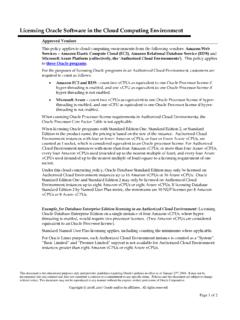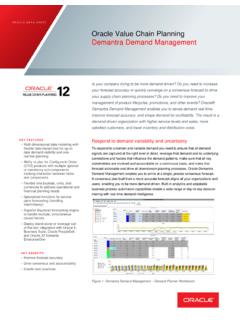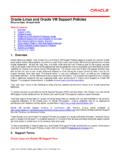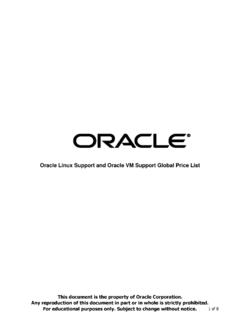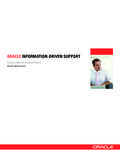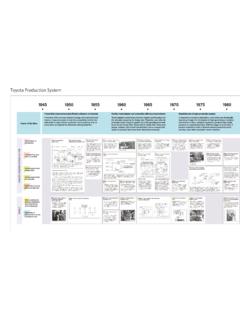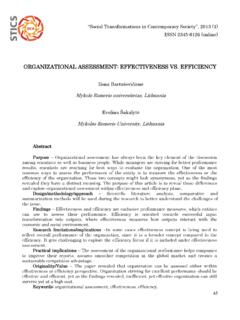Transcription of Financial Consolidation and Reporting Applications - Oracle
1 Financial Consolidation and Reporting Applications Adding Value to Enterprise Resource Planning Systems An Oracle White Paper April 2014. Table of Contents Executive Overview .. 3. Introduction .. 4. Financial Consolidation and Reporting 5. Statutory 5. Management Reporting .. 6. Approaches to Financial Consolidation and Reporting .. 8. What is a Best Practice? .. 9. Adoption of New EPM Technology Improves Performance .. 9. What Functionality is Included? .. 9. Enterprise Resource Planning Systems .. 11. General Tools .. 13. Spreadsheets .. 13. Data Warehouses .. 13. Financial and Enterprise Performance Management Solutions.
2 14. Packaged Solutions and the Fast 17. Integrate .. 17. Improve Accessibility .. 17. Improve Efficiency .. 18. Maximize Information .. 18. Integrating Financial and Transaction Systems .. 19. Adding Value to Multiple Enterprise Resource Planning Systems .. 19. Adding Value to Single Enterprise Resource Planning Systems .. 21. Transitioning to a Single Enterprise Resource Planning System .. 22. Customer Success Stories .. 23. The Extended' Financial Close .. 24. Conclusion .. 25. | 2. Financial Consolidation and Reporting Applications : Adding Value to Enterprise Resource Planning Applications Executive Overview Today's corporations continue to face a vast range of complex Financial Reporting requirements, and ever-increasing scrutiny by auditors and stakeholders.
3 While transaction systems such as enterprise resource planning (ERP) systems typically have general ledger modules that summarize results at period-end, ERPs on their own are not adequate to support the extended Financial close process. Financial Consolidation and Reporting Applications add significant value by enabling flexible, accurate and rapid Reporting , and integrate easily with any ERP system. Financial Consolidation and Reporting Applications are a key component of the extended Financial close enabling an integrated and streamlined process - all the way from the recording of transactions through periodic regulatory filing.
4 Financial Consolidation and Reporting Applications automate the extended Financial close across multiple hierarchies and include support for all of the special calculations required by US-GAAP, IFRS. and other regulatory Reporting standards. See figure 1 below. Figure 1: The Extended Financial Close Process. | 3. Financial Consolidation and Reporting Applications : Adding Value to Enterprise Resource Planning Applications Introduction Financial Reporting requirements come from a variety of sources and are both complex, and ever- changing. Regulatory scrutiny has never been higher especially as a result of the Sarbanes-Oxley Act (SOX) in the United States and International Financial Reporting Standards (IFRS 2005) in Europe.
5 There are various approaches and software packages that can help companies automate the extended Financial close. Of these options, packaged Financial Consolidation and Reporting Applications with purpose-built features will deliver the highest return on investment by improving the speed and quality of the Financial close. To deliver the most value, the finance or accounting staff that compile and create the Financial reports should be able to administer and maintain the Financial Consolidation and Reporting application. Financial Consolidation and Reporting Applications deliver a consolidated book of record'.
6 They provide audit trails and permanent storage of the consolidated results so that internal and external auditors can test and verify data. But Financial Consolidation and Reporting Applications also help organizations with management Reporting , a process by which companies examine and analyze information about business performance to plan for change. Furthermore, these Applications can help with performance statistics that may be non- Financial in nature, for example headcount, inventories, and sustainability metrics. Financial Consolidation and Reporting Applications are part of most enterprise performance management (EPM) solution suites.
7 These solutions complement and integrate with various underlying transaction systems, including ERP systems. The Applications that comprise an EPM system provide comprehensive support for the entire management cycle of goal setting, modeling, planning, monitoring, analysis, and Reporting . Part of the Oracle 's EPM system, Oracle Hyperion Financial Management can be run independently to address this particular segment of the management cycle. But when it is integrated with all the modules of Oracle 's enterprise performance management system, it supports an efficient, closed-loop EPM process that improves business insight and generates better business decisions.
8 | 4. Financial Consolidation and Reporting Applications : Adding Value to Enterprise Resource Planning Applications Financial Consolidation and Reporting Requirements For most publicly traded companies, it is challenging to aggregate historical results in monthly or quarterly reports. One of the greatest challenges is meeting the business requirements for both statutory / legal and management Reporting Statutory Reporting Statutory Reporting refers to the Financial Reporting that helps regulate public companies listed on the world's stock exchanges and the accompanying requirements detailed by governmental bodies such as the Securities and Exchange Commission.
9 This is typically a quarterly Reporting requirement. Statutory requirements come from many sources: The Financial Accounting Standards Board (FASB). The FASB publishes Financial accounting and Reporting requirements The International Accounting Standards Board (IASB). The IASB publishes International Financial Reporting Standards (IFRS) and International Accounting Standards (IAS) in Europe and other countries Government. Accounting rules can come directly from local governments or stock exchanges, such as Japanese statutory requirements that must be complied with for listing on the Tokyo Stock Exchange Regulated industry.
10 Companies in regulated industries, such as banking, insurance, and utilities typically have special statutory accounting and Reporting requirements Tax authorities. All companies must comply with local tax authorities. For example, companies must comply with Internal Revenue Service requirements All these requirements can be broadly defined as statutory or required by the state'. Failure to comply with statutory requirements can cause delisting from public stock exchanges and severe penalties. Also, although these requirements apply to all publicly traded companies, they are often adopted by private companies and not-for-profits as well.
